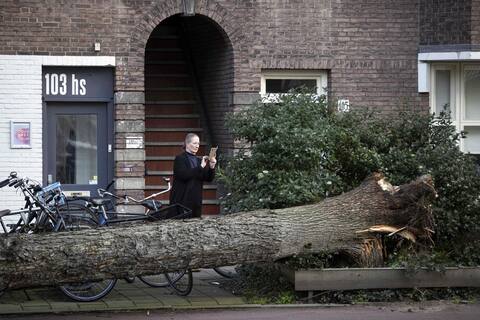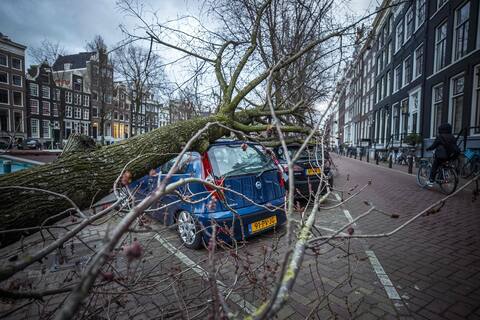Storm Eunice, which battered northwestern Europe, left at least 13 people dead in its wake, as well as extensive property damage and major power outages.
• Read also: Storm Eunice kills at least six in Europe
Forming in Ireland, the storm on Friday passed over part of the United Kingdom and then northern France, the Benelux before continuing its way toward Denmark and Germany, where a large northern third was put on red alert until Saturday morning.
In Germany, more than 1,000 kilometers of railway tracks have been damaged, according to a spokesman for railway company Deutsche Bahn, mainly due to fallen trees, partially paralyzing traffic in the north of the country.
However, the height of the storm has passed and the alert status (level three on a scale of four) has been raised by the German Meteorological Services.
Hundreds of flights, trains and ferries across northwest Europe were canceled as strong winds swept from Eunice in less than 48 hours after Storm Dudley (at least six killed in Poland and Germany).
At this point, 13 deaths from Eunice have been recorded: two in Poland and Germany, four in the Netherlands, three in England, one in Belgium as well as in Ireland.
Many of these deaths are due to trees falling on vehicles.
In the Netherlands, in the capital, The Hague, dozens of homes were evacuated for fear that a church bell tower would collapse. The Dutch rail network has been disrupted and the Thalys links to Amsterdam and Brussels have been cut, with no resumption expected on Saturday, according to a spokesperson.
According to the British Met Office, the Met Office, clearing operations are expected to be disrupted by a new, less powerful storm however, expected in certain parts of the UK, and occasionally snow. At least 226,000 homes were left without power Saturday afternoon in the country, with insurance companies estimating damages at more than 300 million pounds (360 million euros).
Millions are in the same situation in Poland, according to local authorities, and many railways are out of order.
Nearly 200 km/h
In England, a storm of 196 km / h was recorded on the Isle of Wight, which no one had heard of. Among the severe damage caused by the storm, a 400-year-old tree fell on a house in Essex, west of London. “I heard a cracking sound and then a loud bang, the whole house shook,” Sven Goode, 23, who was at his family home, told Sky News. “I felt the whole roof over me, it was so terrifying.”
The British Met Office has issued a red alert level – the highest level – over southern Wales and southern England, including London. This is the first time the British capital has reached this level of alert since the system was established in 2011.
And in northern France, about thirty injuries were recorded, in road accidents related to wind, falls or due to falling materials. About 37,000 homes were left without power on Saturday morning and some regional railways were disrupted.
Strong winds accompanied by high tides have raised fears of flooding, especially with heavy rain expected on Saturday.
Ferry traffic through the canals was halted, hundreds of flights were canceled on Friday, and road and rail transport were affected.
The entire Dutch railway network was affected, only the Paris-Brussels Thales lines were operating on Saturday morning, and a full recovery is expected around 2pm GMT. In Belgium, according to Infrabel, after major repair work at night, most lines were running on Saturdays.
In France, waves sometimes exceeding nine meters were recorded in Brittany (west) as well as gusts of local winds of up to 176 km/h in Cape Grace-Nez (north).
While climate change generally enhances and amplifies extreme events, the link is less clear for winds and storms (except for hurricanes), the number of which varies greatly from year to year.
see also

“Extreme twitteraholic. Passionate travel nerd. Hardcore zombie trailblazer. Web fanatic. Evil bacon geek.”





